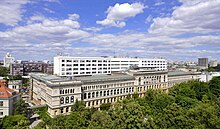New building (construction)

A newly built or rebuilt building is referred to as a new building.
The duration for which such a building is considered to be new is inconsistent and, depending on the context, either extends to the first thorough renovation , until the building shows visible signs of wear or the current architectural style or construction technology has changed so much that the building is so would no longer be rebuilt.
The term is in contrast to the term of the old building .
In the Berlin housing market, all buildings from 1950 onwards are referred to as new buildings and are differentiated into four construction-technical periods, each of which is primarily characterized by a similar construction technology. The transition from the period from the old building to the new building is justified in the Berlin rent index qualitatively by structural features such as clear room heights of less than 3 m, the installation of insulating glass windows and the systematic use of concrete.
Building law differentiation from existing protection
With regard to the renovation of existing buildings and their protection as guaranteed by building law, the definition of a “new building” is of considerable importance.
On the part of the representatives of public building law, the term is usually interpreted very narrowly in such a way that it is a new building if, in a conversion project or building renovation, essential parts of the building fabric, in particular load-bearing structural members, are rebuilt in a different form. A share of at least 50 percent of the existing building fabric is assumed as the lower limit for the protection of the existing building, but often the proportion of new buildings must not be more than 40 percent. What is of central importance here is what these percentages relate to.
If, for example, the existing roof space of a five-storey old building is converted for residential purposes and the entire roof structure is rebuilt 25 cm higher with a modified cubature for this purpose , this means a new building share of 70 percent for the “roof structure” part of the building to be converted; However, if the conversion is applied to the entire building, the proportion of new buildings is a maximum of 20 percent.
The design of these components and the type of construction work in the existing building affect essential building regulations, such as the permissible spacing area and the structural design of space-delimiting components such as walls and ceilings . While the wooden beam ceiling in the old building is subject to the protection of existing buildings, in the case of new residential buildings the floor ceiling must meet fire protection requirements and be of F-90 quality. This requires completely different building structures .
Place names
A new development area is the part of a location that is designated as building land by the development plan and is to be newly built. In some cases this led directly to the name of the district with the same name. Districts with the name "Neubau" are u. a .:
- the 7th district of Vienna new building
- New building in the Waldviertel, Lower Austria
- New building near Röhrenbach, Lower Austria
- New building near Ladendorf, Lower Austria
- a district of the municipality of Fichtelberg in the district of Bayreuth: see Fichtelberg (Upper Franconia)
For individual buildings:
- Neugebude Castle in the 11th Simmering district of Vienna
- New building , part of the municipality of Hörsching , Upper Austria, after the Sachsenburg / Neusachsenburg / Neubau castle
- Protection house new building , in the Goldberg group in the Hohe Tauern
Web links
- Beauty and value of residential real estate: results of a survey by the TU Chemnitz , Nicole Küster & Friedrich Thießen, May 2014 - short summary (2 pages, PDF)
Individual evidence
- ^ Definition of a new building in the Duden
- ↑ Berliner Mietspiegel 2015, p. 9 ( Memento of the original from March 29, 2017 in the Internet Archive ) Info: The archive link was inserted automatically and has not yet been checked. Please check the original and archive link according to the instructions and then remove this notice.